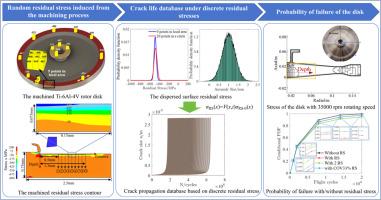考虑机械加工引起的随机残余应力的概率风险评估方法
IF 7.1
1区 工程技术
Q1 ENGINEERING, MECHANICAL
International Journal of Mechanical Sciences
Pub Date : 2024-10-12
DOI:10.1016/j.ijmecsci.2024.109785
引用次数: 0
摘要
航空发动机盘不可避免地会在局部和关键部位出现制造引起的异常和加工引起的随机残余应力 (RS),从而对飞机的安全造成严重威胁。传统的磁盘结构设计无法建立加工过程与失效风险之间的定量相关性。因此,本文提出了一种考虑随机 RS 的概率模型,以量化加工 RS 对低循环疲劳的影响。通过 X 射线衍射测量和正交切削模拟获得的缩放参数对 RS 分散进行了量化。建立了变化 RS 条件下的裂纹寿命数据库,以进行有效的概率计算。结果表明,在加工参数相同的情况下,同一加工表面的局部区域 RS 变异系数 (COV) 为 7.62%,整个加工表面为 13.74%。风险结果表明,由于压缩 RS 延长了疲劳寿命,考虑确定性 RS 的失效概率 (POF) 比不考虑 RS 的失效概率 (POF) 低 2-4%。此外,考虑随机 RS 的 POF 与考虑确定性 RS 的 POF 几乎相同(差值为 0.6%),因为加工 RS 的深度约为 0.2 mm。所提出的方法能更准确地预测 POF,因此对航空发动机钛盘的安全评估很有价值。本文章由计算机程序翻译,如有差异,请以英文原文为准。

Probabilistic risk assessment method considering machining-induced random residual stress
The aero-engine disks inevitably have manufacturing-induced anomalies and machining-induced random residual stress (RS) in localized and critical areas, which cause a severe threat to the safety of the aircraft. Traditional structural design of the disks fails to establish a quantitative correlation between the machining process and the failure risk. Therefore, this paper proposes a probabilistic model considering random RS to quantify the influence of machining RS subjected to low-cycle fatigue. The RS dispersion is quantified using a scaling parameter, obtained by X-ray diffraction measurements and orthogonal cutting simulations. The crack life database under varying RSs is established for efficient probability calculations. Results show that the coefficient of variation (COV) of the RS on the same machined surface with the same processing parameters is 7.62 % in the local area and 13.74 % in the whole machined surface. The risk results show that the probability of failure (POF) considering the deterministic RS is 2–4 % lower than the POF without RS, owing to the extension of fatigue life by compressive RS. Furthermore, the POF considering the random RS is almost the same (difference <0.6 %) as the POF considering the deterministic RS because the depth of the machining RS is around 0.2 mm. The proposed method predicts the POF more accurately and is thus valuable for the safety assessment of an aero-engine titanium disk.
求助全文
通过发布文献求助,成功后即可免费获取论文全文。
去求助
来源期刊

International Journal of Mechanical Sciences
工程技术-工程:机械
CiteScore
12.80
自引率
17.80%
发文量
769
审稿时长
19 days
期刊介绍:
The International Journal of Mechanical Sciences (IJMS) serves as a global platform for the publication and dissemination of original research that contributes to a deeper scientific understanding of the fundamental disciplines within mechanical, civil, and material engineering.
The primary focus of IJMS is to showcase innovative and ground-breaking work that utilizes analytical and computational modeling techniques, such as Finite Element Method (FEM), Boundary Element Method (BEM), and mesh-free methods, among others. These modeling methods are applied to diverse fields including rigid-body mechanics (e.g., dynamics, vibration, stability), structural mechanics, metal forming, advanced materials (e.g., metals, composites, cellular, smart) behavior and applications, impact mechanics, strain localization, and other nonlinear effects (e.g., large deflections, plasticity, fracture).
Additionally, IJMS covers the realms of fluid mechanics (both external and internal flows), tribology, thermodynamics, and materials processing. These subjects collectively form the core of the journal's content.
In summary, IJMS provides a prestigious platform for researchers to present their original contributions, shedding light on analytical and computational modeling methods in various areas of mechanical engineering, as well as exploring the behavior and application of advanced materials, fluid mechanics, thermodynamics, and materials processing.
 求助内容:
求助内容: 应助结果提醒方式:
应助结果提醒方式:


